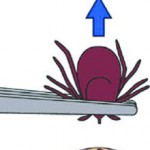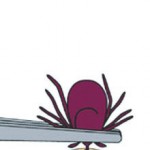Benzie County is home to ticks carrying Lyme disease
Morel mushrooms, leeks, and spring wildflowers draw us outside after a long winter. But hikers need to be mindful of another, more unwelcome spring arrival—ticks.
A rise in tick-borne diseases is the reality as these insects are actively spreading to new areas in Northern Michigan. The Elberta Dunes is one example of a perfect habitat for humans to encounter ticks: it’s wooded, grassy, and sandy with a population of small mammals and deer.
“Benzie County is listed on Michigan’s Lyme disease risk map as endemic, because Lyme disease-infected ticks have been collected in the county,” says Erik Foster, medical entomologist at Michigan Department of Community Health. “These ticks were collected near the shore of Lake Michigan in upland deciduous forest areas. There was one Lyme disease case reported that had exposure in Benzie County in 2013.”


Of the more than 20 Michigan tick species, three are common to Benzie County. It is the blacklegged tick (Ixodes scapularis)—one of the smaller ticks—that is the known carrier of Lyme disease, as well as other diseases. It proliferates in the spring and summer and hangs around into the fall during Indian summers.
Most ticks prefer wildlife, but the blacklegged tick is one of several species that will also sink its ferocious mouthparts into people and domestic animals. While it spends several days feasting on the blood of its generous and unaware host, the tick may also be transmitting the bacteria that causes Lyme disease. Research suggests that a blacklegged tick must latch onto its host for at least 24 hours before the disease-producing organism can be transmitted.
“The practice of checking for ticks cannot be stressed enough,” says Michelle Klein of the Leelanau-Benzie Health Department. “Proper removal in the right time frame removes any chance of infection.”
Klein advises not waiting for test results to confirm Lyme disease if flu-like symptoms develop after being bitten. Rather, seek prompt attention from your healthcare practitioner. Antibiotics are the immediate treatment of choice for a rapid and complete recovery.
Also be on the look-out for ticks on your pets.
“Domestic cats are not prone to Lyme disease, but dogs are,” says Susan Daly, a veterinary medical doctor at the Betsie River Veterinary Clinic in Benzonia. “We had two dogs that had not traveled out of the county [which tested] positive for Lyme disease last week. The blacklegged tick is a cold-weather tick, so it is out and feeding.”
Daly says pets can be screened with a blood test in the office. If treated in the acute phase of two weeks to two months after a bite, the disease can be cured with antibiotics.
If you find a tick on your body or on your pet, remove it according to the pictured instructions. Since tick species are best identified by an expert, save it in a sealed plastic bag with a damp paper towel, and take it—preferably alive—to the local health department.
You may also get submission kits and instructions on how to send it to the Michigan Department of Health at the department’s website, or for more information, contact the Leelanau-Benzie Health Department at 231-882-4409.
Ticks and Your Health: preventing tick-borne illness in Michigan is available online at this link http://1.usa.gov/1gGHSXK, or hard copies of the brochure can be obtained from the Benzie Conservation District at 280 Benzie Blvd. in downtown Beulah.
Prevention Is The Best Cure
• Know where you are mostly like to encounter a tick population: Grassy shorelines, wooded areas, and fields near wooded areas, especially where there are deer.
• Prevent tick bites: Wear light-colored long pants and shirts, closed-toe shoes with pants tucked into socks or boots. Effective insect repellents such as DEET, Picaridin, or oil of Lemon Eucalyptus can be effective for repelling ticks when applied to clothing. Check label recommendations before applying to skin.
• Perform a complete body scan after being outdoors: Most commonly, ticks like to penetrate and attach to the skin in the hairline, ears, waistline, armpit, and groin.
• Remove ticks immediately: Using tweezers or a tick-removal tool, grab close to the skin and slowly but firmly pull straight out without twisting. It is important to remove the tick’s blunt mouth parts which are firmly imbedded in the skin. Thoroughly cleanse the area with soap and water and apply antiseptic.
• Report flu-like symptoms occurring within three to 30 days after exposure to your healthcare provider: Chills, fever, and aching muscles and joints, especially when accompanied with the classic bull’s-eye rash. Be aware that not everyone who contracts Lyme disease gets the bull’s-eye rash. In this acute phase, antibiotics can cure the disease without long-term effects.




